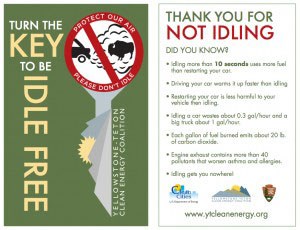Last updated: April 21, 2025
Article
Idle-Free Campaign with Yellowstone-Teton Clean Energy Coalition

Yellowstone-Teton Clean Cities
The U. S. Department of Energy's Clean Cities Coalition National Parks Initiative supports transportation projects that educate park visitors on the benefits of shifting to affordable, domestic alternative fuels, advanced vehicles, and fuel-saving technologies and strategies. Through this program the Yellowstone-Teton Clean Energy Coalition helped the park to develop a messaging campaign to decrease idling by employees and visitors alike. Efforts included vehicle stickers, reminder cards, an Idle-Free pledge for businesses, and education addressing common misconceptions about the need for idling.
The best way to warm up a vehicle is to drive it.
The overall recommendation for an idling ‘cut-off point’ is 30 seconds. Any more than 10 seconds of idling uses more fuel than is required to restart the engine. Wheel bearings, steering, suspension, transmission and tires also need warming up. The only way to do that is to drive the vehicle. Worried about the starter or battery? Thirty second is all it takes.
The overall recommendation for an idling ‘cut-off point’ is 30 seconds. Any more than 10 seconds of idling uses more fuel than is required to restart the engine. Wheel bearings, steering, suspension, transmission and tires also need warming up. The only way to do that is to drive the vehicle. Worried about the starter or battery? Thirty second is all it takes.
Light-Duty Gasoline or Diesel: check your owner’s manual for any specific recommendations, but some good rules of thumb are:
- Above 32° Fahrenheit: no idle time. The best way to warm up is to drive at a moderate speed.
- 0°-32° Fahrenheit: up to 30 seconds to allow for complete circulation of engine oil. If the vehicle occupant(s) is very elderly or an infant, it may be necessary to warm the cabin for their safety.
- Below 0° Fahrenheit: up to 1 to 3 minutes for thickened engine oil to adequately circulate throughout the engine, and for the likely increased time needed for defrosting/deicing.
Heavy-Duty Diesel: the EPA and several diesel engine manufacturers recommend no more than 3 to 5 minutes.
The EPA, American Trucking Association, and several diesel engine manufacturers recommend 3 to 5 minutes to allow for turbo cool-down after full load operation. Engine manufacturers also recommend shut down and restart several times a day, rather than continuous idling, to save fuel and engine wear.
More on Diesel Engines
More on Diesel Engines
- Engine Wear: Advice from engine manufacturers− including those for heavy duty engines−suggest idling no more than 3-5 minutes. Running engines at low speed (idling) causes more wear than driving at a regular speed, which can increase maintenance costs and shorten the life of the engine.
- Restarting: Most newer diesel engines stay warm for several hours after shut down. They retain more than enough heat to keep the engine warm and avoid starting difficulties. Older vehicles may have more difficulty restarting, but don’t assume new engines should be operated like older ones. Check the manufacturer’s recommendations.
- Fuel Gelling: Gelling of diesel fuel used to be a problem years ago, but refiners have created winter blends that better withstand colder temperatures.
Inexpensive windshield covers can be found online or in stores. Or you can try a ground cloth, tarp, bed sheet, or carpet for a do-it-yourself solution.
